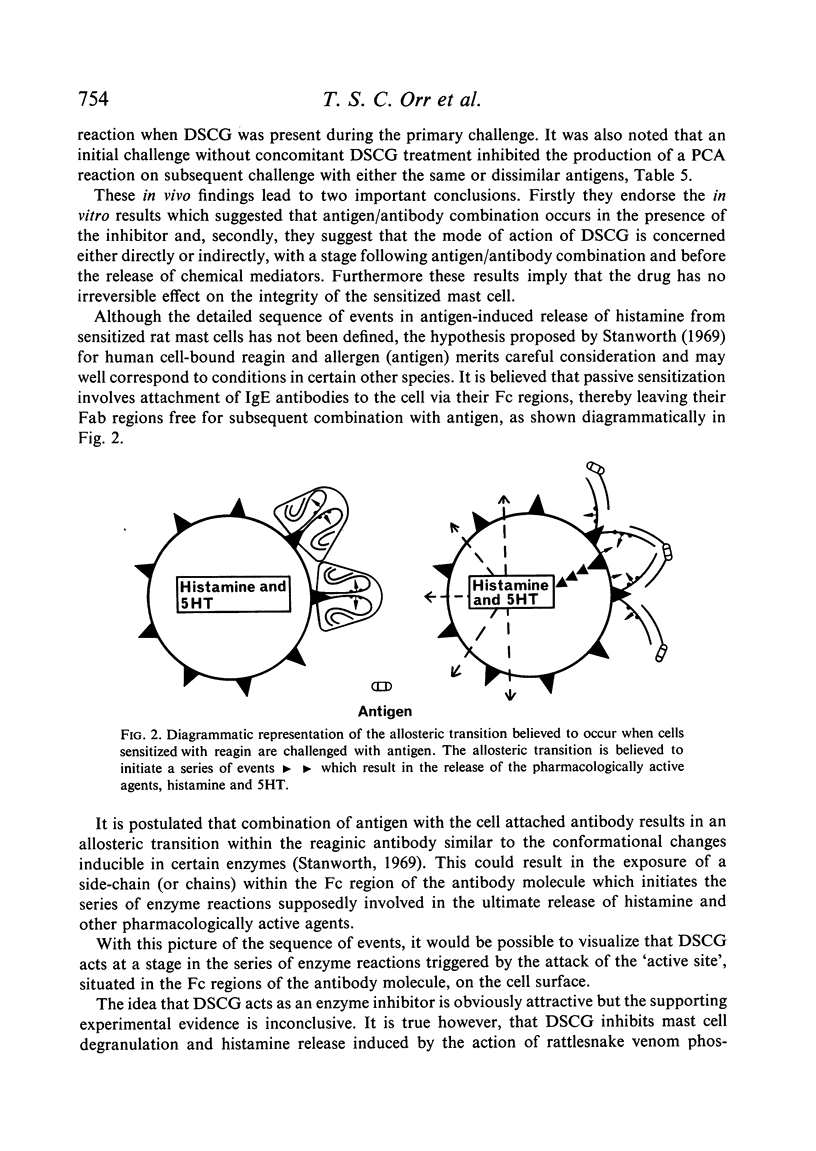Abstract
The mode of action of disodium cromoglycate has been investigated to determine at what stage in immediate type hypersensitivity reactions the compound is effective. In vitro studies using rat subcutaneous connective tissue sensitized with rat reagin revealed that the compound inhibited the allergic release of histamine if present during antigen challenge. The presence of the compound during sensitization had no effect on antigen-induced release of histamine provided the compound was removed prior to antigen challenge. Tissues which had undergone a primary antigen challenge in the presence of disodium cromoglycate did not release histamine when the compound was removed and the tissues rechallenged. These findings indicated that antigen/antibody interaction occurred in the presence of the compound resulting in desensitization to a subsequent antigen challenge. To corroborate the evidence of the in vitro studies in vivo passive cutaneous anaphylactic reactions (PCA) were undertaken using tissue sites sensitized with two reaginic antibodies which permitted a sequence of antigen challenges. Results from these in vivo reactions demonstrated that it was possible to desensitize tissue, without the release of the mediators of anaphylaxis, by an antigen challenge and disodium cromoglycate treatment. In these sites sensitized with two antibodies the immunological reactivity was maintained following a primary antigen challenge and disodium cromoglycate treatment, as a subsequent challenge with the dissimilar antigen produced a good PCA reaction. It would appear that disodium cromoglycate acts either directly or indirectly at a stage following antigen/antibody reaction but prior to the release of the mediators of anaphylaxis.
Full text
PDF












Selected References
These references are in PubMed. This may not be the complete list of references from this article.
- AUSTEN K. F., BROCKLEHURST W. E. Anaphylaxis in chopped guinea pig lung. I. Effect of peptidase substrates and inhibitors. J Exp Med. 1961 Mar 1;113:521–539. doi: 10.1084/jem.113.3.521. [DOI] [PMC free article] [PubMed] [Google Scholar]
- Assem E. S., Mongar J. L. Inhibition of allergic reactions in man and other species by cromoglycate. Int Arch Allergy Appl Immunol. 1970;38(1):68–77. doi: 10.1159/000230260. [DOI] [PubMed] [Google Scholar]
- Assem E. S., Schild H. O. Inhibition by sympathomimetic amines of histamine release by antigen in passively sensitized human lung. Nature. 1969 Dec 6;224(5223):1028–1029. doi: 10.1038/2241028a0. [DOI] [PubMed] [Google Scholar]
- BECKER E. L., AUSTEN K. F. A COMPARISON OF THE SPECIFICITY OF INHIBITION BY PHOSPHONATE ESTERS OF THE FIRST COMPONENT OF COMPLEMENT AND THE ANTIGEN-INDUCED RELEASE OF HISTAMINE FROM GUINEA PIG LUNG. J Exp Med. 1964 Oct 1;120:491–506. doi: 10.1084/jem.120.4.491. [DOI] [PMC free article] [PubMed] [Google Scholar]
- Becker E. L., Austen K. F. Mechanisms of immunologic injury of rat peritoneal mast cells. I. The effect of phosphonate inhibitors on the homocytotropic antibody-mediated histamine release and the first component of rat complement. J Exp Med. 1966 Sep 1;124(3):379–395. doi: 10.1084/jem.124.3.379. [DOI] [PMC free article] [PubMed] [Google Scholar]
- Cox J. S. Disodium cromoglycate (FPL 670) ('Intal'): a specific inhibitor of reaginic antibody-antigen mechanisms. Nature. 1967 Dec 30;216(5122):1328–1329. doi: 10.1038/2161328a0. [DOI] [PubMed] [Google Scholar]
- Goose J., Blair A. M. Passive cutaneous anaphylaxis in the rat, induced with two homologous reagin-like antibodies and its specific inhibition with disodium cromoglycate. Immunology. 1969 Jun;16(6):749–760. [PMC free article] [PubMed] [Google Scholar]
- HARTLEY B. S. Proteolytic enzymes. Annu Rev Biochem. 1960;29:45–72. doi: 10.1146/annurev.bi.29.070160.000401. [DOI] [PubMed] [Google Scholar]
- Lichtenstein L. M., Margolis S. Histamine release in vitro: inhibition by catecholamines and methylxanthines. Science. 1968 Aug 30;161(3844):902–903. doi: 10.1126/science.161.3844.902. [DOI] [PubMed] [Google Scholar]
- Lopez M., Bloch K. J. Effect of disodium cromoglycate on certain passive cutaneous anaphylactic reactions. J Immunol. 1969 Dec;103(6):1428–1430. [PubMed] [Google Scholar]
- MOTA I. THE MECHANISM OF ANAPHYLAXIS. I. PRODUCTION AND BIOLOGICAL PROPERTIES OF 'MAST CELL SENSITIZING' ANTIBODY. Immunology. 1964 Nov;7:681–699. [PMC free article] [PubMed] [Google Scholar]
- Morse H. C., 3rd, Austen K. F., Bloch K. J. Biologic properties of rat antibodies. 3. Histamine release mediated by two classes of antibodies. J Immunol. 1969 Feb;102(2):327–337. [PubMed] [Google Scholar]
- Orr T. S., Cox J. S. Disodium cromoglycate, an inhibitor of mas cell degranulation and histamine release induced by phospholipase A. Nature. 1969 Jul 12;223(5202):197–198. doi: 10.1038/223197b0. [DOI] [PubMed] [Google Scholar]
- Orr T. S., Gwilliam J., Cox J. S. Studies on passive cutaneous anaphylaxis in the rat with disodium cromoglycate. I. Cutaneous reactions induced by an anti-DNP 7S-gamma-2 antibody. Immunology. 1970 Sep;19(3):469–479. [PMC free article] [PubMed] [Google Scholar]
- Pepys J., Hargreave F. E., Chan M., McCarthy D. S. Inhibitory effects of disodium cromoglycate on allergen-inhalation tests. Lancet. 1968 Jul 20;2(7560):134–137. doi: 10.1016/s0140-6736(68)90419-4. [DOI] [PubMed] [Google Scholar]
- Sheard P., Blair A. M. Disodium cromoglycate. Activity in three in vitro models of the immediate hypersensitivity reaction in lung. Int Arch Allergy Appl Immunol. 1970;38(2):217–224. [PubMed] [Google Scholar]
- Sheard P., Killingback P. G., Blair A. M. Antigen induced release of histamine and SRS-A from human lung passively sensitized with reaginic serum. Nature. 1967 Oct 21;216(5112):283–284. doi: 10.1038/216283a0. [DOI] [PubMed] [Google Scholar]
- Stanworth D. R. Immunochemistry of IgE. Proc R Soc Med. 1969 Sep;62(9):971–974. [PMC free article] [PubMed] [Google Scholar]


